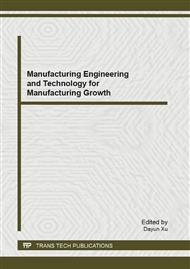p.276
p.283
p.287
p.292
p.298
p.304
p.310
p.317
p.324
The Development of CAD Software for Manufacturing Flat-Face and Roller Cam Systems
Abstract:
Computers have made the greatest impact in the advancement and development of almost all aspect of human endeavour, particularly in the engineering field. In this research, effort is geared towards improving the universal design and final manufacturing of commercial cams in many automotive and other related companies around the world. A software package for the design and profile simulation of plate cams with a possible choice of two followers (Roller and Flat-Face) using eight standard cam motions for over one hundred and eighty-nine different follower profiles has been developed. The developed software provides the tools to analyze critical aspects of cam design before physical prototyping or production of such cams and followers, thereby increasing their reliability and performance. The developed software does not only remove the tedium associated with cam design process but also speeds it up dramatically thereby making the process of comparative design analysis and optimization easier and faster.
Info:
Periodical:
Pages:
298-303
Citation:
Online since:
December 2012
Authors:
Keywords:
Price:
Сopyright:
© 2013 Trans Tech Publications Ltd. All Rights Reserved
Share:
Citation:


